I took a Kia electric car on a 2,000-mile road trip and here's what I learned
To discover if electric vehicles are viable outside of the city, I took the Kia Niro EV on a road trip across the US
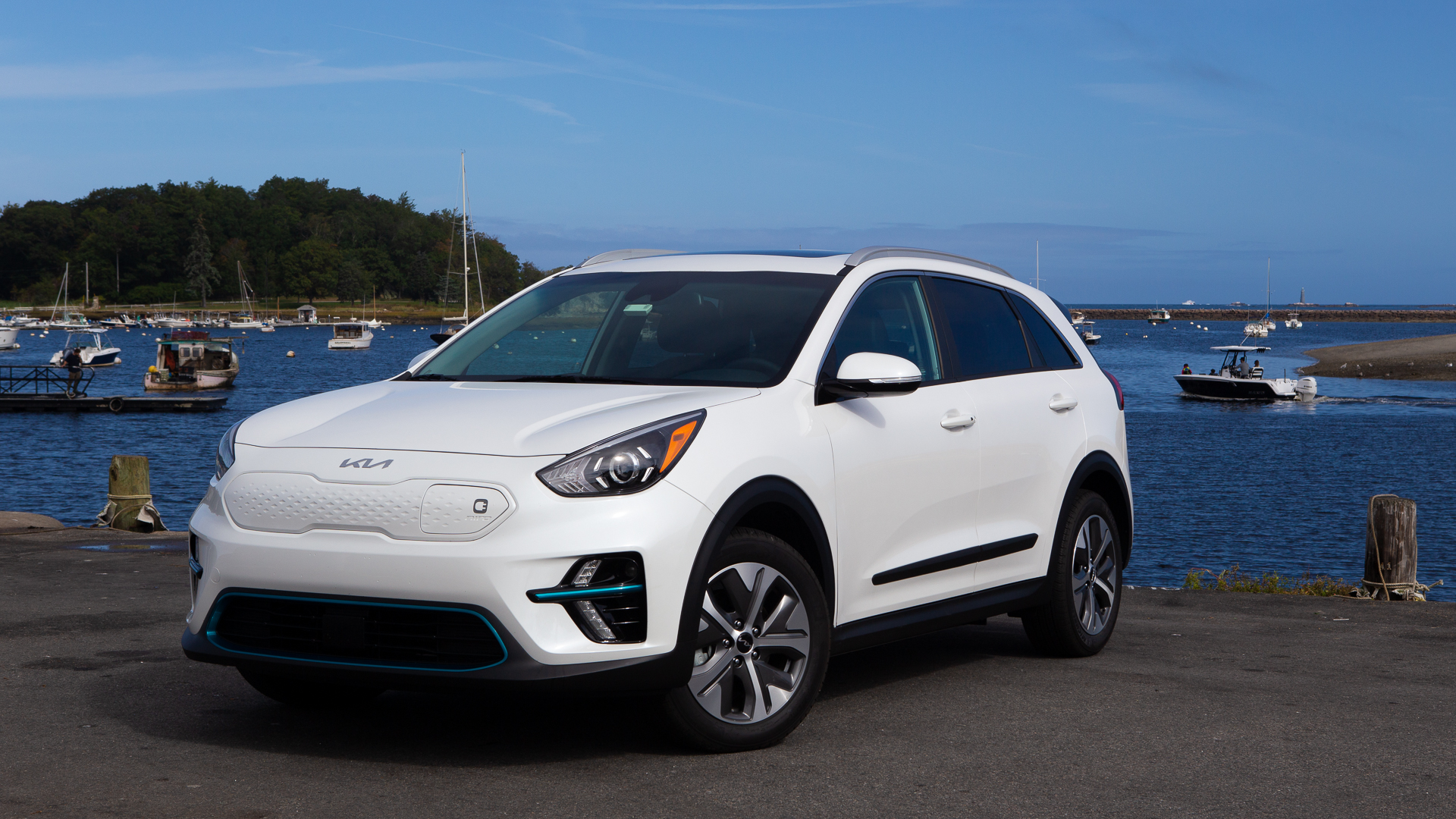

The all-American road trip is the last bastion of the internal combustion engine. While electric cars are seen as a valid solution for inner-city driving, taking one across the country is not something many would try, for two main reasons. First, there’s the range. Most electric vehicles give a range of figures of anywhere from 200 to 300 miles, and while that’s enough to get you between most cities in the UK, it won’t even get you out of most states in America. Then there’s the charging. Are there enough stations to keep your EV charged up on those longer journeys, or do you run out of options once you leave the safety of the city?
I recently got the chance to try out the Kia Niro EV. It claims a 239-mile range and fast charging. Well, who would turn that down? With faith in both the electric vehicle and the ever-improving charging network, I took the challenge to try it for myself. In true Griswolds style, I planned my own National Lampoon Vacation, traveling the 2,000-mile journey from Chicago to Boston and New York – and back.
No, I never made it to Wally World, but here's how my journey went, and what I learned.
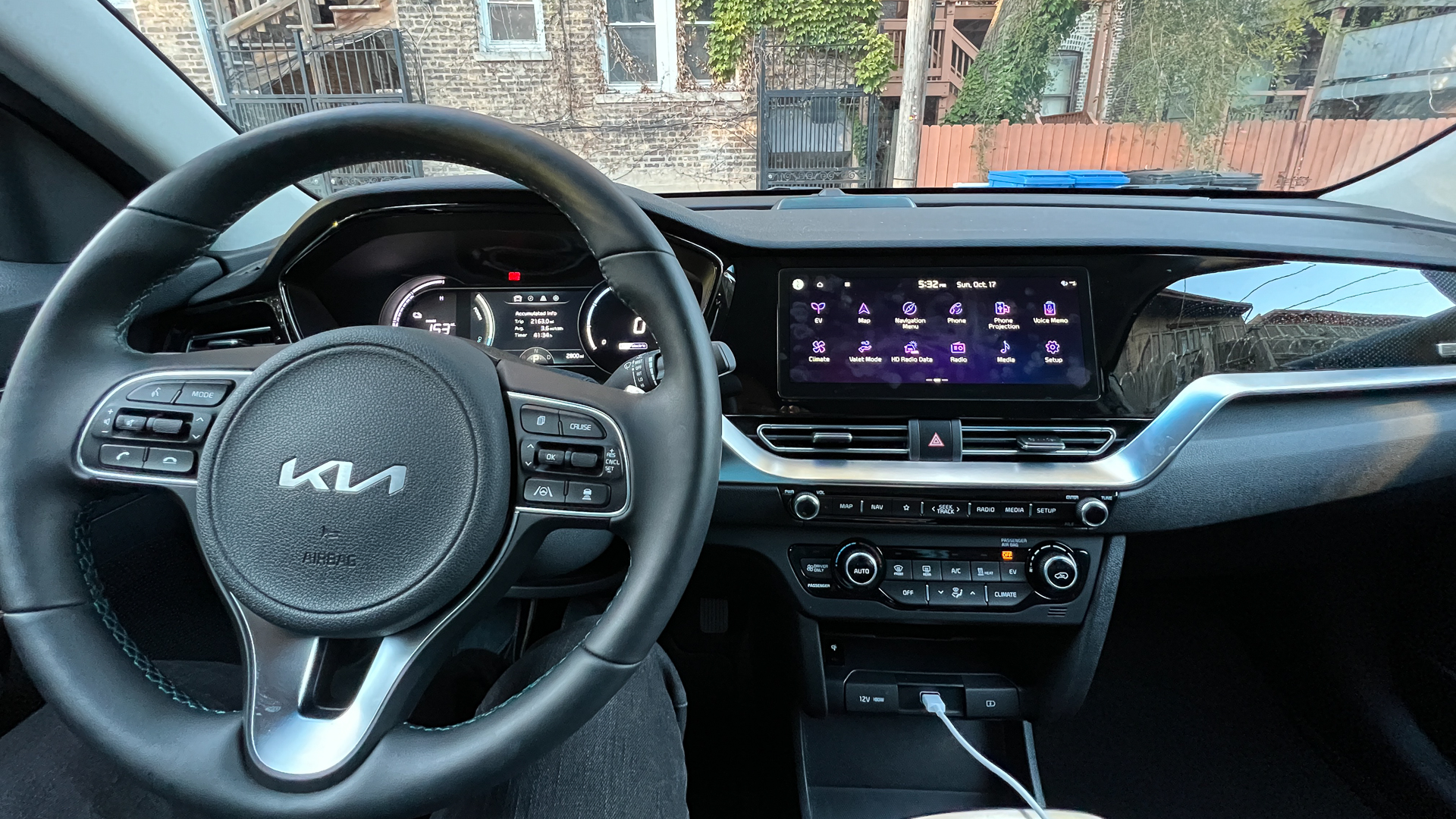
The interior of the Kia Niro EV features a 10.2-inch center screen for infotainment, including Apple CarPlay or Android Auto.
Kia Niro EV
My vehicle of choice for this trip was the Kia Niro EV (or e-Niro in the UK). This is a fully electric vehicle based on the original gas-version. As such, the design is more traditional than many of the dedicated EVs and from most angles it looks a lot like a regular crossover SUV.
The exception is that front grill, which is a solid body-colored panel and incorporates the charging port. It’s amazing how much this small detail can change the look of the car and even when I wasn’t parked in an electric charging bay, people asked about it.
The 2022 Niro EV starts from $39,900 or $32,490 after tax credit (£30,395 in the UK and AU$67,490 in Australia), which makes it a very affordable EV, if still quite a hike from the standard gas and plug-in hybrid models. It’s similar money to the Volkswagen ID.4 and Hyundai Kona Electric and compares well. The model I used for the trip was the Niro EV EX Premium, which starts from $44,650.
The Niro EV has a 239-mile estimated range, which is slightly less than the ID.4 and Kona but only by about 20 miles. It can charge from a regular plug socket or anything up to 100kW fast chargers, which allows it to charge up to 80% in just over an hour.
Get all the latest news, reviews, deals and buying guides on gorgeous tech, home and active products from the T3 experts
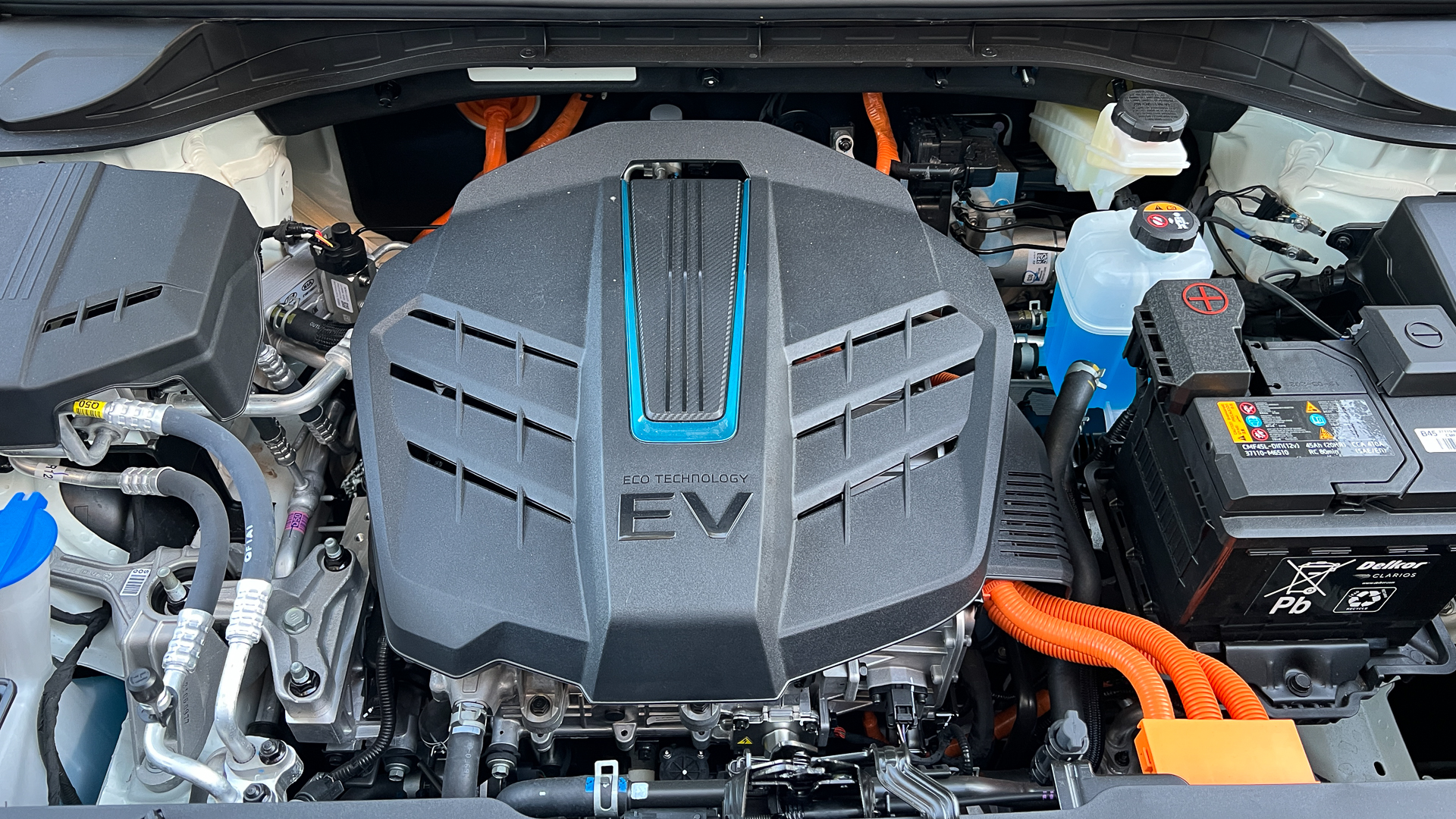
The engine compartment on the Kia Niro EV looks a lot like a standard internal combustion engine arrangement.
The crossover SUV design means there’s lots of space inside, in the front seats, back seats and in the trunk. The rear seats can even be folded forward for larger storage capabilities. Unlike dedicated EVs that often gain a front storage area, lifting the hood here reveals a very familiar looking engine arrangement – complete with coolant and screen wash containers.
The driving position is quite high, which is ideal for longer drives and the controls are all at your fingertips. This includes entertainment and phone buttons on the left of the steering wheel, vehicle controls on the right and paddles that control the amount of regenerative braking used. When set to level three regenerative braking, the vehicle starts to brake heavily when you take your foot off the accelerator, allowing you to almost drive with one pedal. The lower settings (one and two) are less noticeable and let you drive as normal.
There’s a 10.2-inch touchscreen display in the center for both entertainment and vehicle features, as well as a large digital instrument panel behind the steering wheel. The UX is pretty slick here, with its purple neon icons on a black background and retro touches, like the valve app design on the radio. Its own mapping also includes all available charging points, as well as a distance radius to help you see how far you can travel. You can of course use Apple CarPlay or Android Auto by plugging your phone into the central USB port. This is also paired with an 8-speaker, plus sub, Harman Kardon surround sound system for some really powerful sound.
The UVO app lets you control the vehicle from your phone once you pair it. You can start and stop the engine remotely, lock or unlock the doors, start or stop charging and preplan routes.
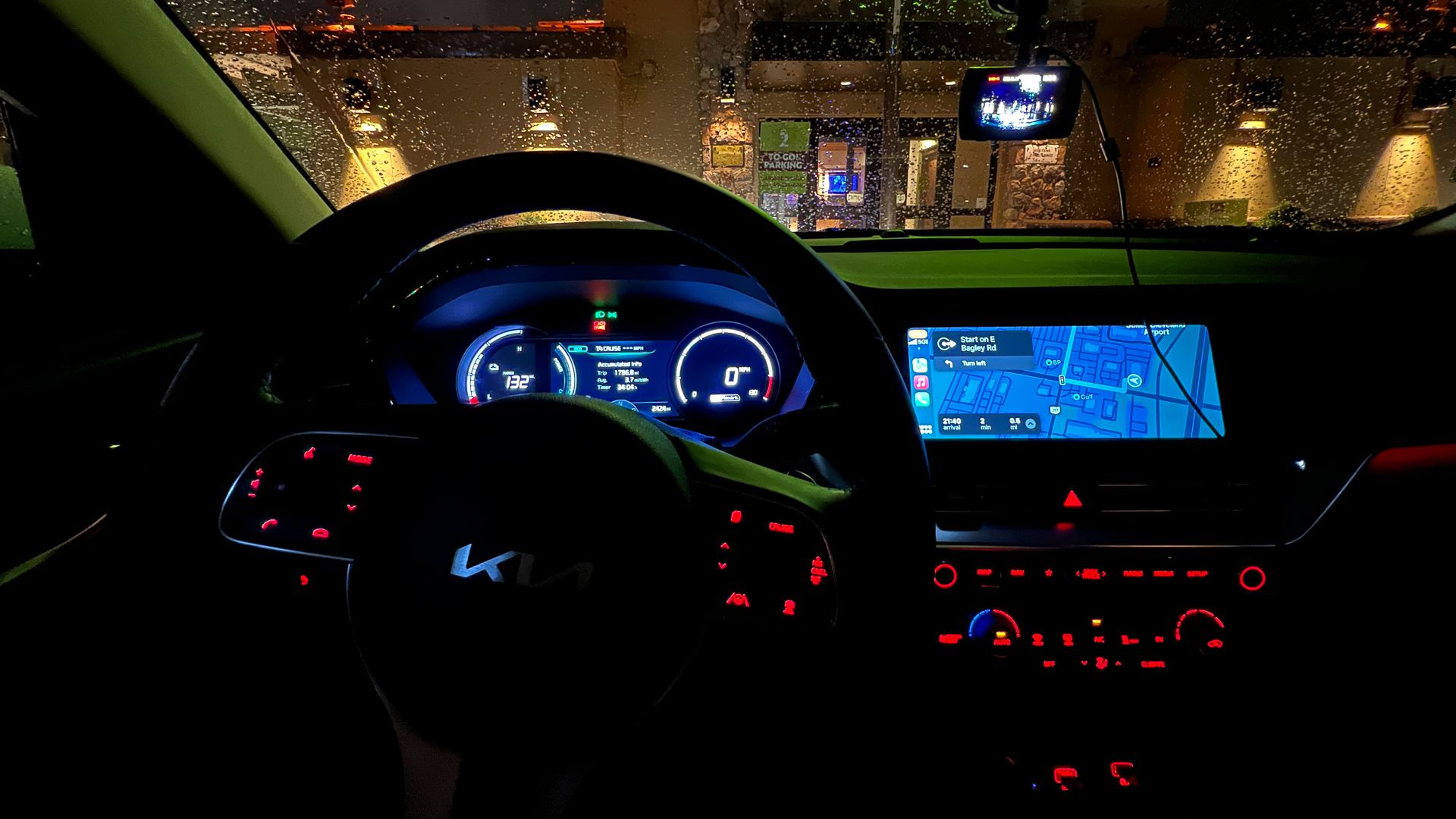
The night-time display of the Kia Niro EV is a sea of red.
The Niro EV has a range of driver-assist technologies built-in too. Forward collision avoidance alerts to any hazards, while the blind-spot collision warning beeps loudly if there’s a vehicle in your blind spot and you indicate to change lanes into its path. This is useful but often overly cautious, unless you leave a big gap in front or behind a vehicle, it will still alert you, even when there’s space.
While there’s not a high level of autonomous driving here, the combination of the Lane Following Assist (LFA) and Navigation-Based Smart Cruise Control – Curve with Highway Driving Assist (NSCC-C) is very helpful. The LFA can be used at any time and corrects the steering to stay within the lane markers. It’s definitely helpful for motorway driving as it takes care of those small adjustments and even those more severe road curves.
I did find I needed to correct it regularly to avoid coming out of the lane and left to its own devices would bounce between the left and right markers rather than stay central. However, I realized how much easier the LFA was making the driving after driving for a short distance without it.
The smart cruise control was my favorite feature though, and meant that I spent at least 90% of my highway driving with my feet off the pedals. You can set the speed manually and the car will not only reach that top speed, but it will also reduce your speed to match the car in front if that is slower – even down to a full stop. On highways, you can also set the speed limit into the Auto mode, which will then adjust your top speed to the road’s current speed limit. This was really handy when roads suddenly switch from 70 to 50mph.
Overall, this was the perfect electric car for longer journeys.

The Kia's proprietary mapping is capable and provides charging information.
The 2,000-mile trip
A journey from Chicago to Boston, if taken directly, is just under 1,000 miles and would take just over 15 hours. To break this up into something more manageable, I planned to stop off at Niagara Falls – around 560 miles into the journey and just under nine hours drive. From there it would be another 470 miles to Boston and around seven hours of driving (plus traffic).
On the return trip, I first headed down to New York City, a short 232 miles, then on to Scranton, Pennsylvania, another 121 miles, before taking the longer journey to Cleveland (420 miles) and then back to Chicago (345 miles).
I knew that eight hours was the most driving I could manage in a day, and that charging time would add at least a couple of extra hours to each of the journeys. For that reason, aside from that first long stretch, I kept the potential journey time within that window.
I figured that with a range of just under 240-miles and a 2,148-mile total journey, I should need around 10 charges throughout the trip. What I hadn’t considered was the extra drain on the battery for faster speeds, air conditioning and the combined weight of my family and luggage. I also hadn’t taken into consideration the range anxiety of waiting until the last minute to charge or the extra time needed to go from 80 to 100%.
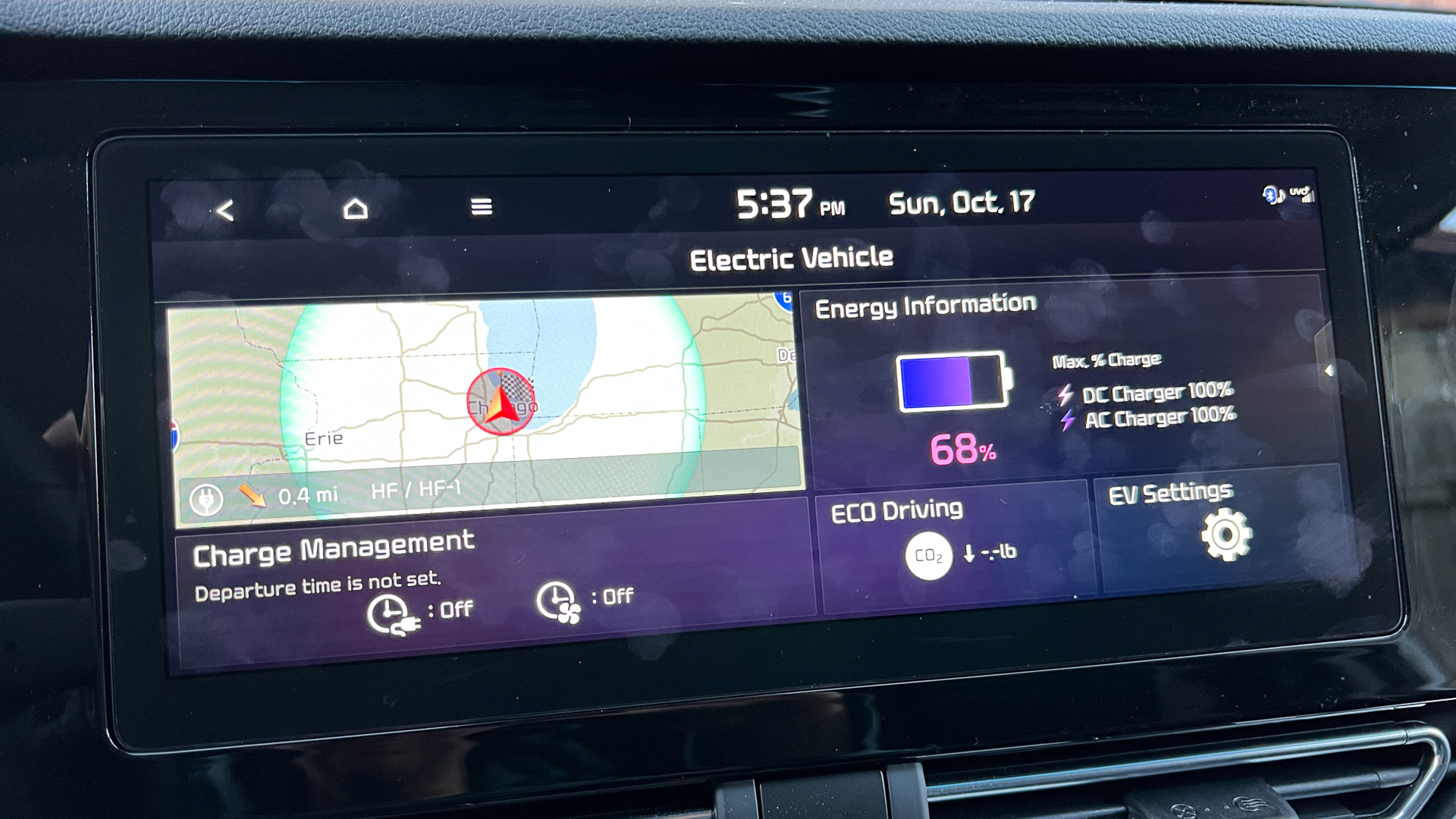
The EV menu on the Kia Niro EV provides a visual range view as well as charge management, usage info and eco settings.
Route planning for an electric vehicle
For the first stage of the trip, I plotted my route from Chicago to Niagara Falls and then found the first charging point that was just within the 240-mile range. As it turned out, this was around 200 miles away, just into Ohio.
Setting off with confidence that I had at least 40 miles extra in the tank, I took the car up to the speed limit and overtook as needed – all while enjoying the cool aircon in the unseasonably warm October weather. However, as the journey went on, I soon realized that my 40 miles of grace was slipping, and fast.
As the difference between my distance left to travel and my remaining range dropped to 20 miles, I took action. First dropping my speed and then switching off the aircon. I also discovered that I had left the car in sports mode, so switched to eco mode. There’s also an eco plus mode, which limits your speed to 60mph and turns off all unnecessary functions (including the aircon).
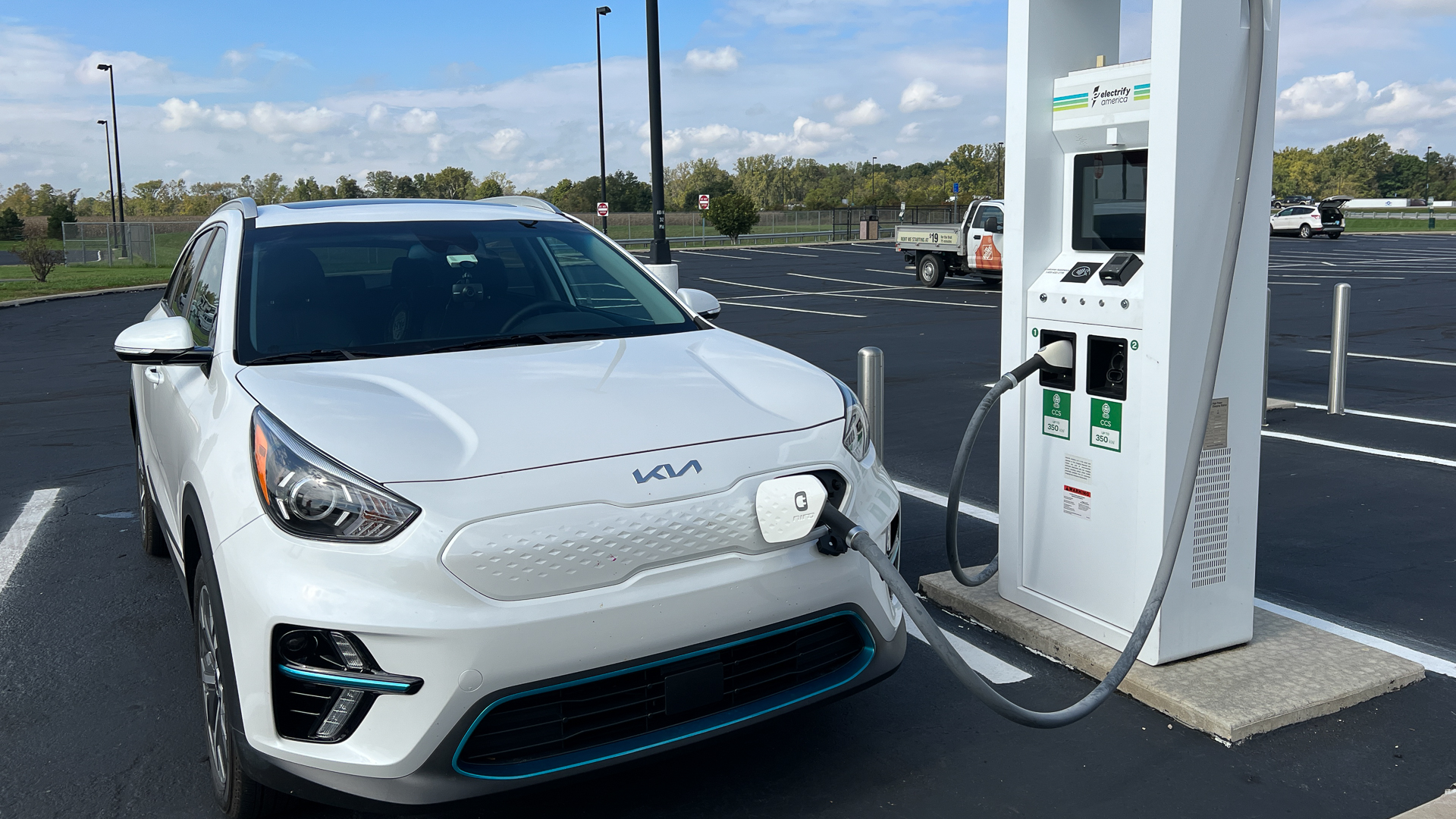
Charging at an Electrify America fast charger
I arrived at the first charging stop with around 12 miles of range left, having spent the last hour constantly monitoring the range and distance figures to make sure I still had enough to last. I vowed at this point to pick shorter drives to reduce the stress levels.
From then on, I kept my planning to a maximum of around 160 miles between charges. This gave me plenty of spare range, so that I didn’t have to drive to frugally and it meant that I was stopping every two to two and a half hours, which was about right for a break.
I found that while it’s possible to find the charging points on Apple Maps for CarPlay, it was easier to find them using a dedicated charging app. The Electrify America app shows the locations of its fast chargers across the US, and it was easy to identify the one on my route at the right distance away, then click the directions button to add the destination to Apple Maps.
I still prefer the systems offered by Tesla and Google Automotive, which allow you to add charging points into your journey and give you an estimate of your remaining charge on arrival. Hopefully, this will come to Apple Maps in the future. In the meantime, an App called A Better Route Planner (ABRP) also does a great job at providing all this in one place. You can even add details of your car model and your current charge level before setting off.
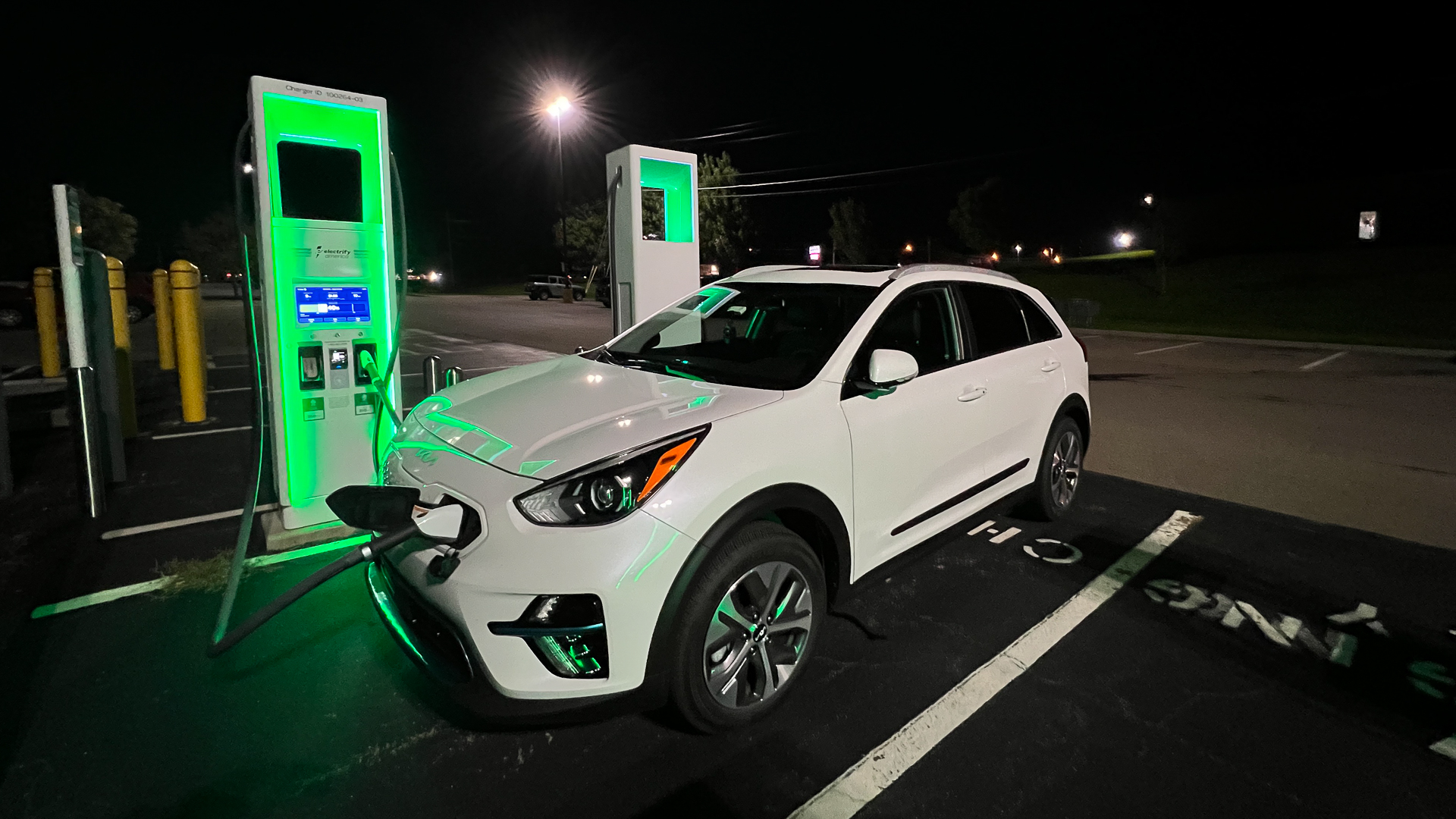
The Electrify America charging stations are easily found, thanks to their green lighting.
Electric Vehicle charging
When it came to charging, I went for speed over price and looked for the fastest chargers. These were usually the Electrify America chargers, which offer 90kW, 150kW and 350kW options.
The model of electric car you have will determine which chargers you can use. There are different connectors and speed requirements. In the US, the most common connector is the J1772 (apart from the Tesla type), and this was available at every charging station that I came across. The Kia Niro features a CCS port, which can also use the J1772 connectors.
I was able to plug into any of the 90kW, 150kW or 350kW stations but my maximum charging speed didn’t top 100kW, as this is limited by the vehicle. As the battery fills, the charging speed actually reduces, to avoid overloading the battery. This means that even if you start at around 80kW, by the time you reach 80% charge, this has reduced to 25kW or less.
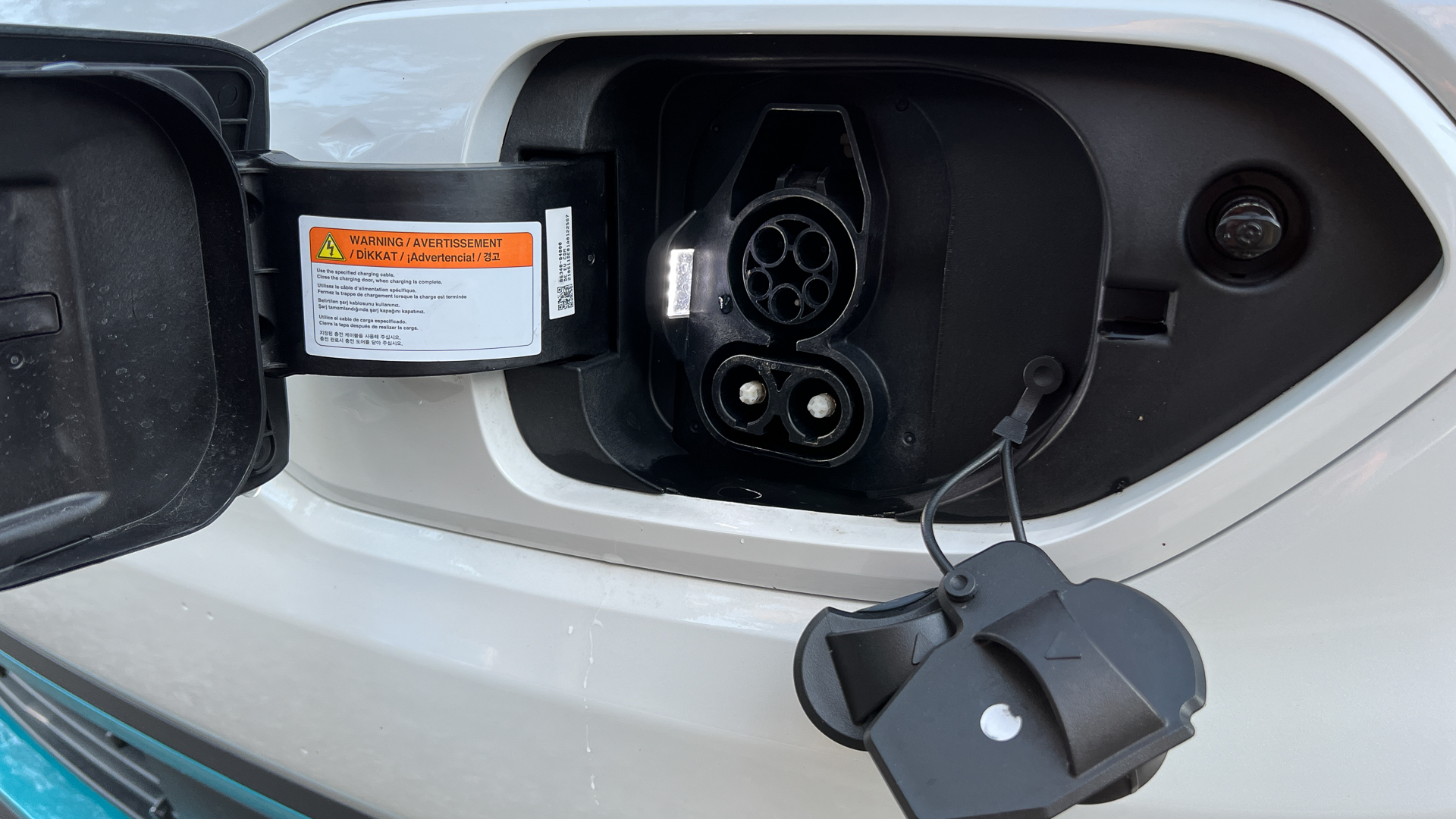
The CCS charging port on the Kia Niro EV is compatible with the common J1772 connectors, and CCS connectors.
Practically, this means that, while it takes around an hour to go from 10 to 80%, it takes another hour to do the final 20%. So, for journey efficiency, it makes more sense to only fill to 80% and stop more frequently than trying to charge to 100% each time.
The exception to this of course is when you are stopping for the night. I found that most of the fast chargers were outside of cities, and the ones close to where I was staying were trickle chargers, that offered 7.5kW charging. While these take at least nine hours to fully charge, they work well for an overnight option.
In New York, many of the parking lots provide EV charging and so I had my charge topped up that way. In Boston I plugged into a friend’s regular power socket in his shed, using the charging lead supplied with the Kia Niro. From a 110V outlet, this was even slower and took over 30 hours to fully charge the car. While it’s certainly a useful option to have, I’d recommend investing in a dedicated 240V home station charger or making use of public chargers.
One question that was often asked of me was how much it cost to fill up. Unfortunately, the answer is – it depends. While some of the trickle chargers are free, the faster charging stations charge either per kW or per minute, with different rates for the fast and regular chargers. You can also pay a $4 monthly fee with Electrify America, which gets you 25% off the charging rates.
Typically, I paid around $15 to fill to around 80% using a fast charger, which is around $0.33 per kW. As the Niro also informs me that my average power use was 3.6 miles per kWh, which works out to be around $0.09 per mile.
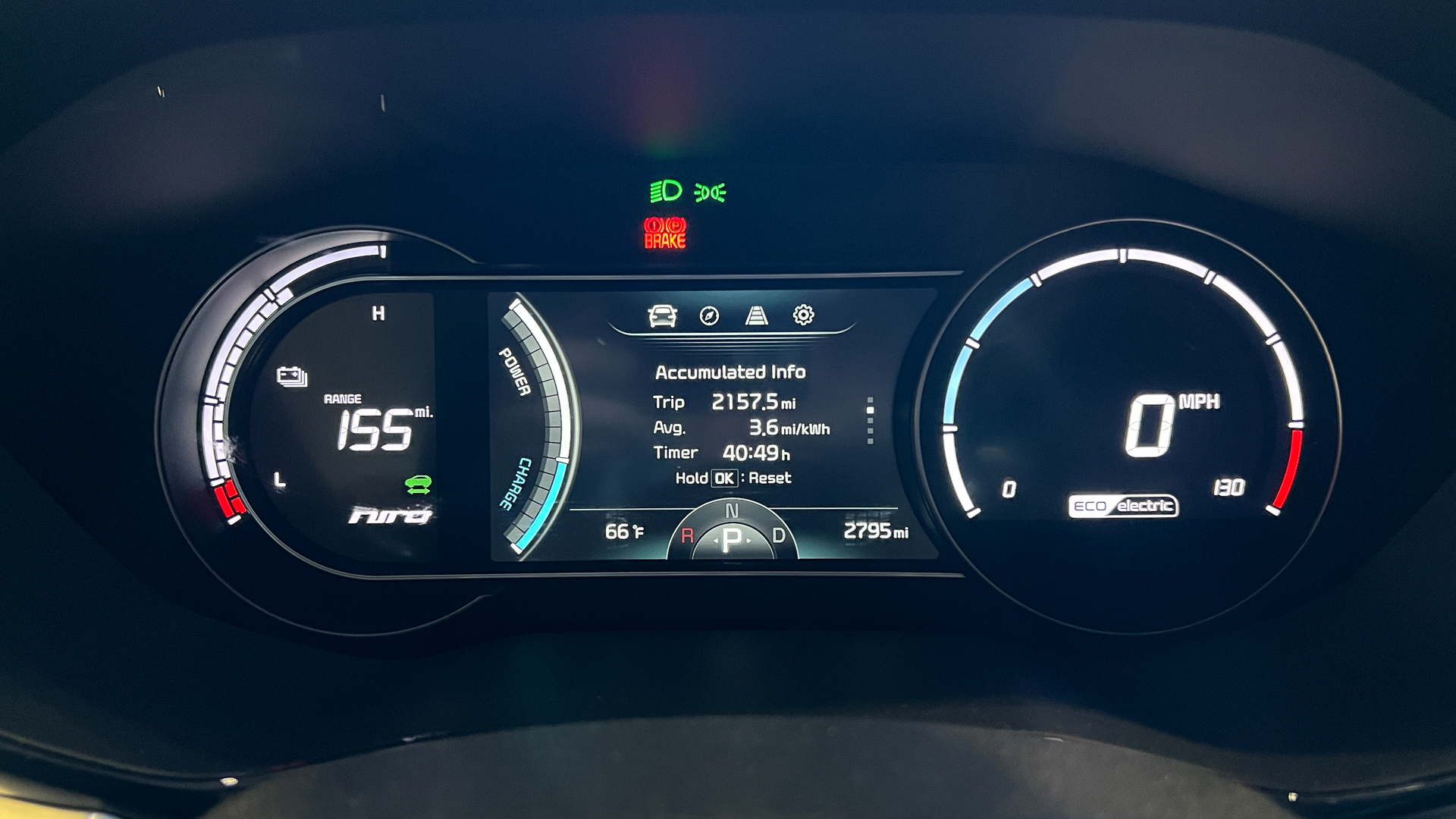
Does an EV work for road trips?
The short answer here is yes, though you do need to plan your trips better. The limiting factors remain the range of the cars and the availability of charging points. While I never had trouble finding a charger, they are nowhere near as readily available as gas stations, and rarely in the same place. Only two of the stops I made were with chargers at existing gas stations. The others were in industrial estates, Walmart parking lots and rest stops.
Most of the charging stations had a maximum of five spaces for electric cars to charge and not once did I have to wait for a space. But as the number of electric cars on the road increase, this is not likely to be the case for long. If every gas station invested in its own bank of chargers, it would make things a lot easier.
Range will also play a massive consideration in the number of chargers needed. As the average range of electric vehicles increases to 400 or even 500 miles, most journeys won’t need to involve a stop at all. With a 500-mile range, even my longest journey of the trip would have only needed one charge.

As T3's Editor-in-Chief, Mat Gallagher has his finger on the pulse for the latest advances in technology. He has written about technology since 2003 and after stints in Beijing, Hong Kong and Chicago is now based in the UK. He’s a true lover of gadgets, but especially anything that involves cameras, Apple, electric cars, musical instruments or travel.